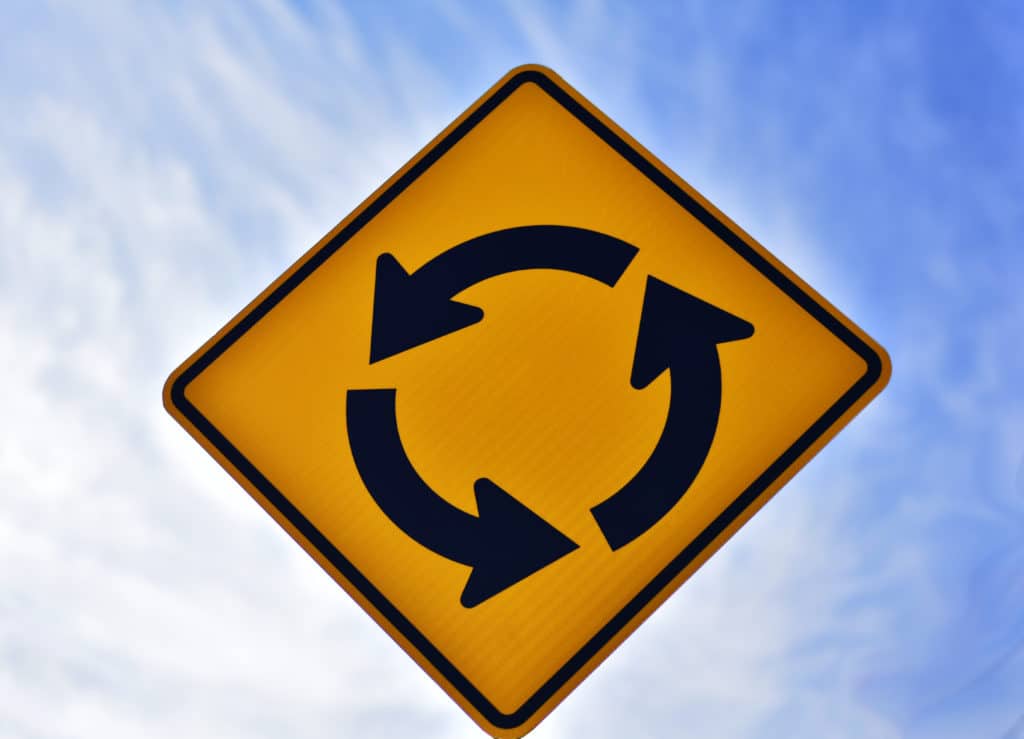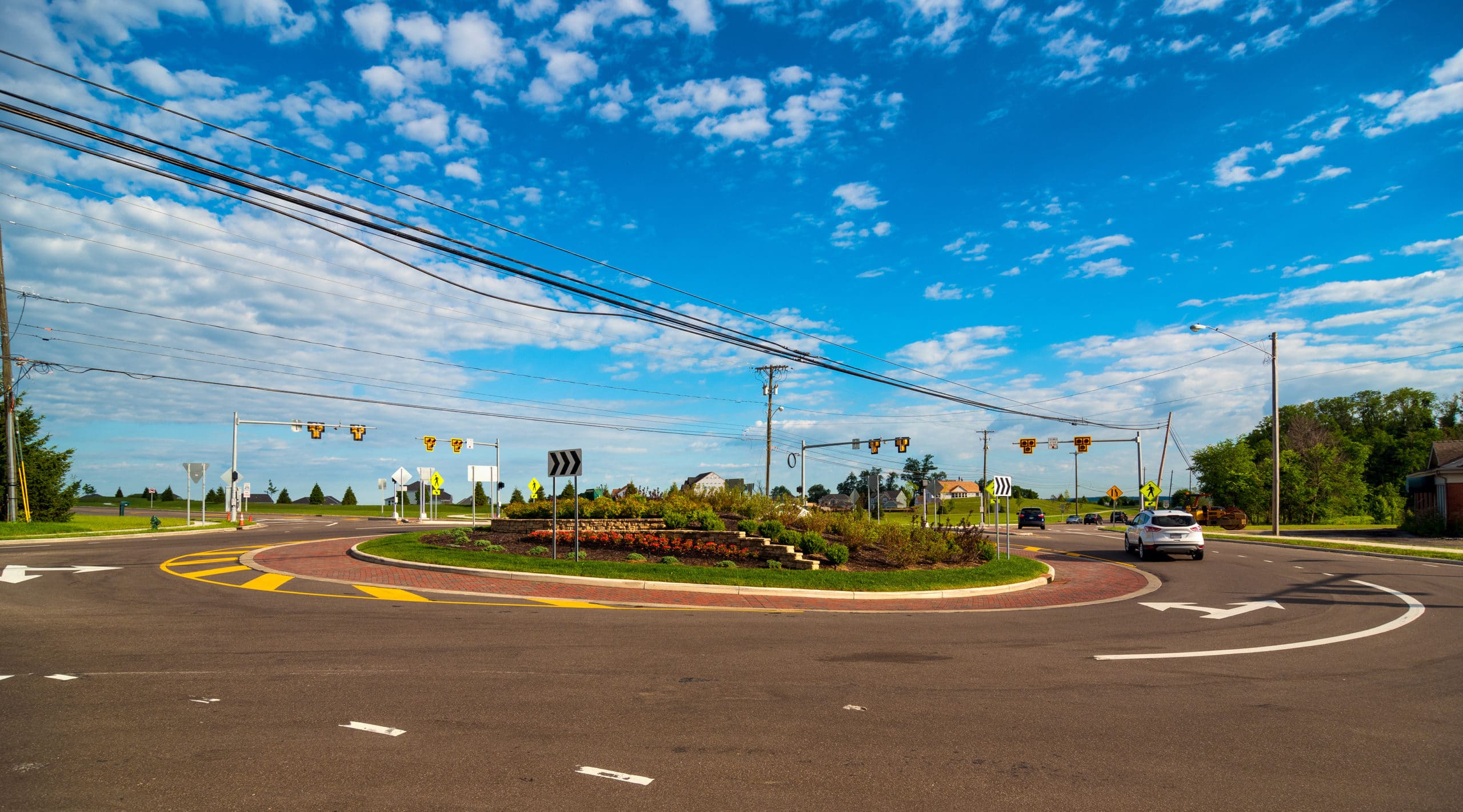

Has a roundabout or traffic circle recently appeared in your area? You might remember, Pennsylvania’s first roundabout appeared in Richland Township, Bucks County. Designed by Carroll Engineering, it featured a 20-foot-wide concrete apron and connected Old Bethlehem Pike and Station Road. But, what are the benefits of roundabouts? To start, roundabouts improve safety, reduce vehicule speeds and generally improve traffic conditions.
According to ongoing studies from FHWA and the National Cooperative Highway Research Program, roundabout crashes are reduced by approximately 75 percent and fatalities are lessened by 90 percent compared to traditional signalized intersections. Therefore, when there are two high-volume roads, such as Old Bethlehem Pike and Station Road, the installation of a roundabout benefits the neighborhood immensely. And in little time, drivers became naturally comfortable. It is beneficial to know what a roundabout is, explore the benefits, and learn about driving tips.
What is a Roundabout?
A modern roundabout is a circular intersection where traffic flows counterclockwise around a central island. Roundabouts are yield-controlled, allowing continuous traffic flow at slow speeds. Vehicles entering a roundabout must yield to vehicles already circulating the intersection, then enter the intersection and exit at their chosen street.
The Benefits of Roundabouts in Traffic Operations
Improved Safety
There are a few key reasons why roundabouts provide improved safety for drivers, pedestrians, and cyclists. Let’s see how it has helped Richland Township.
Fewer Conflict Points
Since all vehicles within roundabouts travel in the same direction, there are fewer conflict points. In other words, the vehicle-to-vehicle contact is limited to the “front-to-back” crashes. For instance, a traditional 4-legged signalized intersection has 32 conflict points, whereas a single-lane roundabout has only 8. Therefore, there are reduced head-on collisions or “T-bone” interactions between vehicles. The vehicle crash rate has been reduced and the neighborhood made safer overall.
Reduced Travel Speeds
Before entering roundabouts, drivers must slow down and yield to traffic. With speeds in roundabouts often between just 15-25 miles per hour, collisions that do occur are generally minor and cause far fewer injuries than traditional signalized intersections. With slower speeds, the driver is made more aware of the surroundings.
No Traffic Lights to Beat
Roundabouts promote a circular flow of traffic, therefore there are no traffic lights to interrupt flow. Since traffic is constantly moving through these intersections, drivers don’t feel the need to accelerate to make it through a traffic light and through the intersection.
Enhanced Efficiency for Circulating Traffic
Contrary to what you might believe, roundabouts provide a more efficient way to move traffic through intersections. Since roundabouts are continuously flowing, and yield-controlled, they can handle a larger amount of traffic in the same amount of time than a regular intersection. Vehicles aren’t forced to wait at red lights when other movements have green lights, sometimes up to 2 minutes. Roundabouts also reduce congestion on approaching roads. Overall, they help drivers get to where they need to go in quick timing.
Reduced Maintenance Costs
Traffic signals require electricity 24/7 and the maintenance cost associated with it can become expensive. Signalized intersections require a lot of equipment in order to function. If a signal blacks out, the intersection can cause chaos, vehicles will back up for miles, cars will get stuck trying to make a left turn, and crashes will skyrocket. Typically, roundabouts only need electricity for streetlights at night, which leads to reduced electricity costs. And maintenance is only necessary for nearby landscaping.
Decreased Vehicle Pollution
When a roundabout is free of traffic, vehicles entering the intersection aren’t required to stop. This opportunity for free-flowing traffic eliminates the frustrating stop-and-go associated with stop signs or intersections controlled by traffic signals. Richland Township’s air quality is improved by their roundabout, making it safer for residents to spend outside. Reduced stop-and-go traffic leads to fewer idling vehicles and decreased vehicle pollution overall.
Increased Aesthetic Opportunities
Typical intersections controlled by traffic signals require large, unsightly paved areas to accommodate the full range of turning movements needed. A roundabout provides a welcome opportunity for landscaping and artwork with central space. The concrete treatment that was used for the Old Bethlehem roundabout simulates fieldstone that matches the old Shaw Homestead located on the corner. Within the center, a garden was added to appeal to the surrounding greenery.
How to Drive in a Roundabout
Roundabouts alert drivers’ attentiveness and vigilance while reducing the focus to a centralized point. When entering at an angle, the driver is forced to look upon entering. The driver’s focus is to the left where vehicles are coming from, and in front, where pedestrians might be crossing.

Here are our top tips for driving in a roundabout intersection:
- Slow down as you near the roundabout.
- Watch for vehicles, pedestrians, cyclists, and directional signs.
- Always Yield to pedestrians, cyclists, and vehicular traffic before entering.
- Think about which lane you need to be in before entering.
- When you notice a gap in traffic, enter the roundabout with caution.
- Drive in the lane that corresponds to your exit.
- Know before you go. Research your trip before leaving and learning about any new roadway construction will keep you alert and aware.
Roundabout Design Services with Carroll Engineering Corporation
At Carroll Engineering, we specialize in traffic and transportation engineering and have highly-qualified engineers who work on streetscape design projects to traffic impact studies… and everything in between! Our team’s in-depth professional experience makes them uniquely poised to help you design more effective roadways equipped with roundabouts and other unique features. Learn more about our traffic and transportation engineering services and check out our featured projects!
When you’re ready to start your next project or have any questions about roundabouts contact our Traffic & Transportation Engineering Department Manager, James Graham, P.E., PTOE, at jgraham@carrollengineering.com or 215-343-5700 ext 276.

